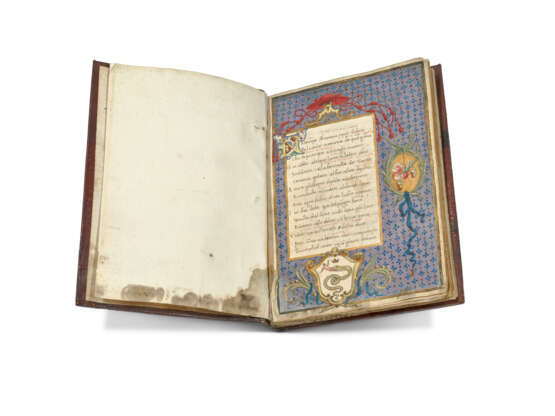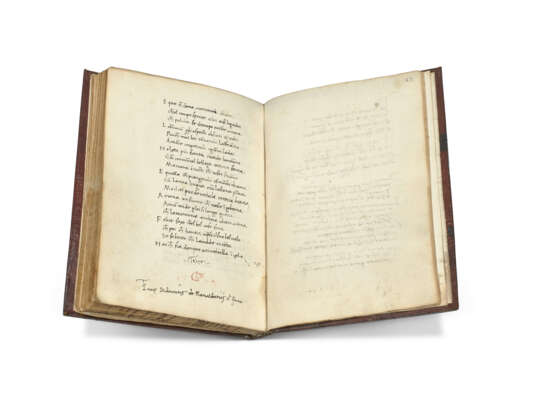ID 1349787
Lot 17 | Francesco Petrarca (1304-1374)
Valeur estimée
£ 25 000 – 35 000
Trionfi, in Italian, illuminated manuscript on paper [Italy, ?Urbino, final quarter 15th century]
One of the greatest works of Italian lyric poetry: a manuscript copy of Petrarch's Trionfi, written in the Tuscan vernacular and owned by Cardinal Antonio Eugenio Visconti.
203 x 136mm. i + 56 + i leaves, complete, collation: 1-510, 66, modern foliation in pencil followed here, 21 lines written in terza rima in a clear humanistic hand by Lodovico Ranalducci, written space: c.140 x 75mm, vertical catchwords survive, contemporary annotations in red ink in Latin to the first two pages, a few scattered maniculae, illuminated white-vine initial on f.1, spaces left blank for initials of other capitoli, full-page illuminated border with coat of arms, cardinal's hat and emblem added in the 18th century by Cardinal Eugenio Visconti (some marginal dampstaining, a few small wormholes, gutters reinforced, a few smudges, else in excellent condition). Bound in 18th-century reddish-brown morocco tooled in blind (a little scuffed).
Provenance:
(1) Ludovico Ranalducci da Fano: 'Finis Ludovicus de Ranaldutiis da fano' on f.52v. The same scribe signs a vellum copy of Petrarch's Trionfi from the Library of San Michele in Murano, described in Bibliotheca Codicum Manuscriptorum Monasterii S. Michaelis Venetiarum prope Murianum, Venice, 1779, col.869-870. The writing has the appearance of a humanist's, rather than a professional scribe's, and it seems likely that Ludovico copied the text for his own use. The watermarks match Piccard-Online IT5235-PO-31959, localisable to Urbino, 1491. This would fit neatly with the scribe's home town of Fano, a seaside town in the province of Urbino.
(2) Antonio Eugenio Visconti (1713-1788), cardinal, titular archbishop of Ephesus, Apostolic Nuncio to Poland and Austria: his coat of arms and emblem - the famed Visconti biscione and glowing firebrand with hanging pails (symbolising ardour tempered by prudence). As cardinal his titular church was Santa Croce in Gerusalemme. He took part in the conclave of 1774–1775 that elected Pope Pius VI and became Prefect of the Congregation for Indulgences and Holy Relics in 1782.
(3) Sir Thomas Phillipps (1792-1872): his Middle Hill bookstamp on front flyleaf and manuscript number 249. Sold at Part V of his posthumous series of sales at Sotheby's, Bibliotheca Phillippica, lot 471.
Contents: Francesco Petrarca, Trionfi, ff.1-52v: Triumph of Love, beginning: 'Nel tempo che renova i miei suspiri' f.1, '[E]ra si pino el core de miravegli' f.5, '[P]oschia che mia fortuna in forza altrui' f.9v, '[S]tanco gia di mirare non satio ancora' f.13v; Triumph of Chastity, beginning '[Q]uando ad un giogo & in un tempo quivi' f.18, '[Q]uanti gia nel eta matura & acra' (appearing as the second capitolo of the Triumph of Chastity as per the 6 March 1473 Parma edition of Andreas Portilia), f.23; Triumph of Death, beginning '[Q]uella ligiadrea e gloriosa donna' f.23, '[L]a nocte che segui lhorribel caso' f.27v; Triumph of Fame, beginning: '[N]el cor pien d'amarissima doglia' f.32, '[D]a poi che morte triumpho nel volto' f.36, '[P]ien dinfinita e nobil maraveglia' f.39, '[N]on sapea de tal vista levarme' f.43; Triumph of Time, beginning '[D]e laureo albergo cun laurora inanzi' f.46; Triumph of Eternity, beginning '[D]a poi che sotto el cel cosa non viddi' f.49v; excerpt from Canzoniere CXXXIV: 'Pace non trovo et non no da far guerra', in a second contemporary hand, and two sonnets in a third contemporary hand, the first by Agostino Staccoli da Urbino (c.1420-1474), beginning 'D'una e d'altra pieta me strengne amore'; the second by the 14th-century poet Niccolò Cieco, beginning 'Rido con lun pensier collaltro piagno', f.53v; blanks ff.54-56v.
Our manuscript contains various spelling and other textual variants, reflecting the continued evolution of the text: for example the Triumph of Fame opens on f.32 with 'Nel cor pien d'amarissma doglia' ('dolcezza' in other versions), a capitolo that Petrarch eventually discarded after Laura's death in 1348 in favour of 'Da poi che morte' (here on f.36).
The Trionfi, written over a period of twenty years, was enormously popular in the 15th century, and has endured as one supreme works of Italian literature. Structured in six allegorical 'triumphs', it was composed in the form of a vision where allegorical figures, accompanied by appropriate characters from history, mythology and the Bible, succeed one another from the initial triumph of Love over the human heart until the final triumph of Eternity over Time. Laura, and Petrarch's love for her, are the central themes and it is through her that the poet has hopes of attaining his ultimate salvation and thus the chance of seeing her again.
Exhibited
National Book League, October 1954, 'In Praise of Italic', no 13.
| Lieu d'origine: | Italie, Europe |
|---|---|
| Catégorie maison de vente aux enchères: | Manuscrits médiévaux et de la Renaissance, Livres et manuscrits |
| Lieu d'origine: | Italie, Europe |
|---|---|
| Catégorie maison de vente aux enchères: | Manuscrits médiévaux et de la Renaissance, Livres et manuscrits |
| Adresse de l'enchère |
CHRISTIE'S 8 King Street, St. James's SW1Y 6QT London Royaume-Uni | |
|---|---|---|
| Aperçu |
| |
| Téléphone | +44 (0)20 7839 9060 | |
| Commission | see on Website | |
| Conditions d'utilisation | Conditions d'utilisation |







